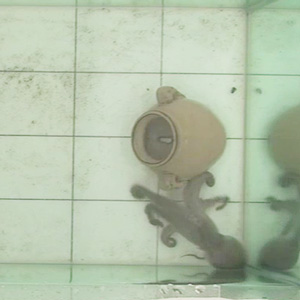
The octopus is a fascinating creature and probably the smartest invertebrate known. It has an extremely well developed visual system with high acuity, and although it cannot distinguish color, it can see polarized light. Scientists have proposed that octopuses communicate with each other by polarizing the light that reflects from their scales, creating a messaging system that could not be observed, much less understood by other creatures in their realm who have much less sophisticated visual systems (1).
Many animals rely on visual stimuli for recognizing predators, food and other members of their species. And scientists have used pictures, models and videos to attempt to understand how visual cues affect animal behavior. Pictures and models lack the movement aspect of live stimuli, so video playback presents the best, controllable method, for presenting visual stimuli. However, video has been designed for the human visual system, not that of the octopus, and until recently no video study has managed to elicit a biologically appropriate response from cephalopods (octopus, cuttlefish or squid). Continue reading “Are we finally smart enough to learn from the gloomy octopus?”
